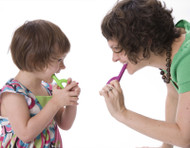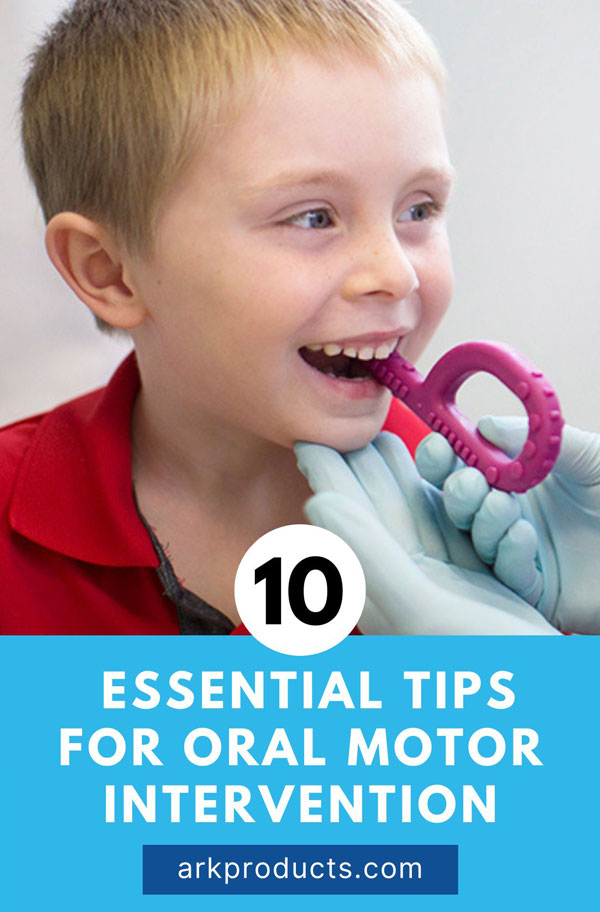10 Essential Tips for Skilled Oral Motor Therapy: Expert Considerations
Posted by Stephanie Feero, MS, CCC-SLP on 15th Nov 2024
Oral motor intervention can be a valuable tool in speech and feeding therapy, but it requires a skilled, systematic approach to support proper orofacial function and development. If you are interested in oral motor therapy but aren’t sure where to start, you’re not alone! ARK is excited to share with you these ten considerations for skilled oral motor intervention to guide your practice!
.
.
1. Build Trust and No Means No
The first priority in any intervention is always the patient’s well-being. Building trust, rapport, and a safe space to make progress is essential to optimal outcomes. Oral motor intervention can be demanding and sometimes invasive - think about it as an adult, having a random person touching your face, mouth, and asking you to make movements that are incredibly difficult is NOT a fun idea! Before engaging in the demands of direct intervention, ensure you spend time developing a solid, safe relationship with your patients. For some, this can mean one or two sessions and they’re ready to go, but for other children this process can be a lengthy child-led process and it’s important to remember that not all therapy sessions have to look the same - take time to just play together, be silly, and consider that a child’s past sensory experiences highly influence their skills today.
And of course, a no is ALWAYS a no. If a child is uncomfortable with an activity, it’s our job as a safe, trusted professional to stop! Many of the children we see in speech also have sensory regulation differences, so it’s critical we keep in mind that a seemingly “simple” activity to us can be incredibly distressing to a developing body. We can try to modify an activity to a child’s comfort level, and a good therapist will scaffold activities to meet the child where they’re at!
2. Prioritize Personal Hygiene
Always maintain strict hygiene standards, including trimmed nails, handwashing before and after sessions, a sanitization protocol, and wearing gloves.* For products, best practice is for each patient to have their own set of oral therapy tools.
3. Know the Norms
You simply cannot identify deviations and delays if you do not strongly understand the developmental norms for speech and feeding development. Ensure you study and understand typical oral motor skills. When I have graduate student clinicians, I encourage them to do an oral mechanism exam on as many patients as possible so they can start their careers well versed in the variations of oral motor structure and function. The knowledge of typical development will enable you to identify exactly where in the developmental process a skills is deviating and create a skilled intervention plan to address the deficit to achieve a skill!
4. Assess, Assess, Assess
A comprehensive evaluation should be the very first step when a new patient is in front of you. For speech and feeding concerns, this includes a variety of assessments that can include articulation and phonological assessments, feeding assessment measures including oral trials, patient/parent interview, sensory profiles, and feeding log assessments. And to me, one of the most foundational assessment tools in oral motor therapy is the oral mechanism examination.
When I was a clinical fellow, I had a child working on articulation and we had foregone the oral mechanism exam in the evaluation due to time running out. We were several sessions into therapy when I looked in his mouth for the first time to help him with a placement cue. On the posterior portion of his palate there was a small dot, and upon closer inspection it appeared to be a hole! This child had a very tiny palatal fistula that no one had ever identified - even his doctor! Needless to say I learned my lesson early on that I would always do an oral mech exam because you never know what can be present!
5. Accept That You Don’t Have All the Answers
No one has all the answers, which can be a hard reality when there are limited therapy options for struggling families. Oral motor therapy can be complex, and it's okay to admit when you need more information or a different approach. Be adaptable and open to learning from new research, colleagues, and the child’s response to therapy.
6. Collaborate with Other Professionals
Speech and feeding issues often intersect with other areas and a team of professionals including occupational therapy, physical therapy, dentistry, otolaryngology (like my little patient with the fistula!), and nutrition. Collaborate with a multidisciplinary team to provide holistic care and ensure all aspects of the child’s needs are addressed. And as stated above, if you feel out of your wheelhouse it is always okay to refer to another speech language pathologist who may have a different set of skills to more functionally address issues out of your wheelhouse!
7. Always Prescribe a Home Program and Support the Family
Direct intervention in the speech room lays the foundation for improvement! But home practice is often essential for oral motor intervention. Make sure you empower families with home programs that are simple and practical. Provide ongoing support and check-ins to help families implement strategies consistently. This can often include calendars, check lists, and helping parents set reminders in their phones for dedicated homework time to accomplish assigned tasks.
8. Be the Patient: Experience the Exercises Yourself
Perform the exercises you plan to use on yourself first. This allows you to understand the sensations, effort, and coordination required, enabling you to better guide and empathize with your clients! In oral motor therapy this process has highlighted some tasks that are difficulty for me to perform too, which impacts my ability to effectively model certain tasks! This knowledge helps me improve my therapy.
9. Know Your Resources
Stay updated with current research, tools, and techniques. I highly recommend pursuing a variation of continuing education courses from different CEU providers and programs to create a dynamic approach to your intervention! Utilize evidence-based resources and professional guidelines to inform your practice and enhance your clinical decision-making.
10. Integrate Oral Motor Therapy into Functional Skills
This item is one of the most critical factors in differentiating evidence based intervention from non-efficacious exercise programs. It is essential in oral motor therapy to link all oral motor activities to the real functions of the muscle groups you are addressing. For example, in a session I may be using the ARK Probe Tip with the Z-Vibe to facilitate lingual lateralization, and in that session I always ensure that the lingual lateralization is then practiced in the context of feeding - such as chewing on a preferred snack to practice the lateralization skill we just established. Isolated exercises without context aren’t beneficial - instead, practice skills in a way that is meaningful and practical for the patient.
I hope this list of considerations is beneficial for your practice! Share with us your ideas and considerations for oral motor intervention and check out the ARK Therapeutic blogs for helpful tips and strategies to implement oral motor intervention into your therapy sessions!
Stephanie Feero, MS, CCC-SLP

Stephanie is a speech language pathologist in Washington state. She has worked with individuals with speech, feeding, and myofunctional disorders for the past 8 years of her career and has observed many patients greatly improve their speech and feeding skills with the use of oral motor intervention strategies!
Stephanie is also the creator of Chomper Champs - A Speech Therapy Companion Tool, which she developed to provide SLPs with engaging, quality speech products to target speech, language, feeding goals. You can find Stephanie at her website, chomperchamps.com or follow her on Instagram @chomper_champs_speechtherapy


